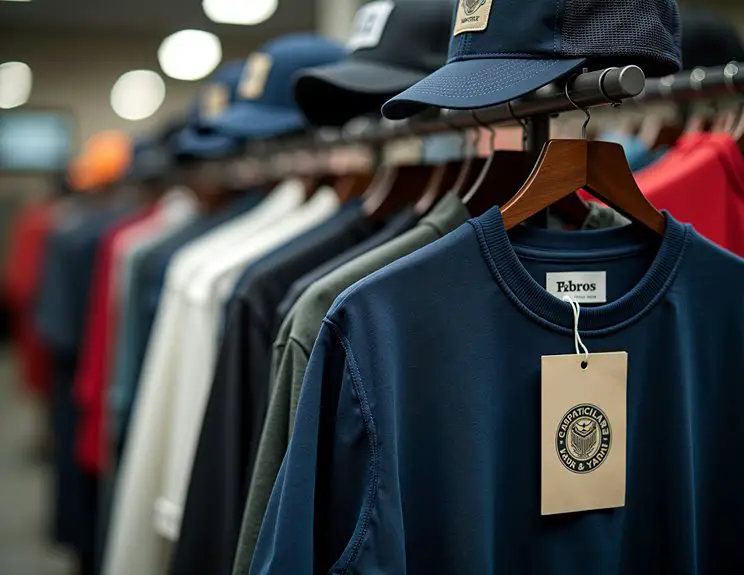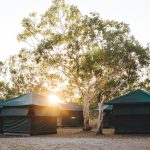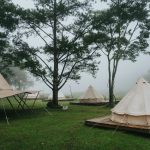If you want rugged durability and solid build quality, Berghaus offers reliable polycotton tents with excellent airflow. For budget-friendly options that set up quickly, Vango’s tents balance affordability with practical features. But if you prioritize spaciousness and premium comfort for family camping, Outwell leads with larger layouts and great moisture control. Choosing the best depends on your camping style and needs, and exploring each brand’s strengths will help you find the perfect match.
Table of Contents
Key Takeaways
- Berghaus tents offer excellent airflow with a 65% cotton blend and robust waterproofing, ideal for serious adventurers in tough conditions.
- Vango provides budget-friendly polycotton tents with 60% cotton, featuring easy setup and decent seam sealing for casual camping.
- Outwell’s polycotton tents use 70% cotton for superior moisture control and spacious interiors, perfect for family campers seeking comfort.
- Berghaus excels in durability and quick-pitch systems, while Vango emphasizes stability with TBS II and Outwell prioritizes ventilation and roomy layouts.
- Customer reviews favor Berghaus for ruggedness, Vango for simplicity and affordability, and Outwell for premium comfort and large capacity.
Comparing the History and Reputation of Berghaus, Vango, and Outwell
While Berghaus, Vango, and Outwell all have strong footholds in the outdoor gear market, each brand carries a unique history and reputation that shapes what you can expect from their polycotton tents.
Berghaus, founded in 1966, earned a reputation for innovation and durability, catering to serious adventurers. You’ll find their tents emphasize ruggedness and performance.
Berghaus tents are known for their ruggedness and durability, perfect for serious adventurers seeking reliable performance.
Vango, with roots dating back to the 1960s, focuses on practical design and affordability, making their tents a popular choice for family campers and casual users.
Outwell, established in the 1990s, quickly built a reputation for comfort and spaciousness, tailoring tents to those who prioritize ease and luxury in camping.
Knowing these backgrounds helps you pick a tent that fits your camping style and expectations.
Materials and Fabric Quality in Polycotton Tents
Because the fabric forms the core of any polycotton tent, understanding its materials and quality is essential when choosing your gear. Each brand uses a unique blend and weave density to balance breathability, durability, and water resistance. You’ll find that Berghaus emphasizes high-grade cotton blends, Vango focuses on weatherproof coatings, and Outwell integrates innovative fabric treatments for longevity.
| Brand | Fabric Composition | Breathability |
|---|---|---|
| Berghaus | 65% cotton, 35% polyester | Excellent airflow |
| Vango | 60% cotton, 40% polyester | Moderate airflow |
| Outwell | 70% cotton, 30% polyester | Superior moisture control |
Knowing these differences helps you pick a tent that suits your camping style and climate conditions perfectly.
Design Innovations and Features Across the Three Brands
When you explore polycotton tents, you’ll notice that design innovations greatly influence your overall camping experience.
Berghaus focuses on user-friendly layouts, offering quick-pitch systems and smart storage solutions to keep your gear organized.
Vango impresses with its integrated AirBeam technology, replacing traditional poles with inflatable beams, making setup faster and more flexible.
Outwell prioritizes comfort, incorporating spacious living areas and innovative ventilation systems that reduce condensation and improve airflow.
Each brand also pays attention to entryways, with Berghaus and Outwell providing wide, easy-access doors, while Vango offers versatile porch areas for extra shelter.
These features show how each brand tailors its designs to different camping styles, helping you find a tent that fits your specific needs without compromising ease or functionality.
Weather Resistance and Durability Performance
You’ll want to check how each tent handles waterproofing and seam strength to stay dry in tough conditions.
Pay attention to the fabric quality and thickness since they directly impact durability.
Also, consider how well the tents resist wear and tear over time to guarantee long-lasting performance.
Waterproofing and Seam Strength
Although polcotton tents offer natural breathability, their waterproofing and seam strength determine how well they protect you from harsh weather.
When you choose between Berghaus, Vango, and Outwell, pay close attention to their waterproof ratings and seam taping. Berghaus often uses high-quality waterproof coatings combined with fully taped seams, so you can trust it to keep water out during heavy rain.
Vango also provides strong seam sealing, but some models may need extra seam sealing applied for intense conditions. Outwell emphasizes reinforced seams and durable waterproof layers, ensuring you stay dry without compromising breathability.
Ultimately, your tent’s ability to withstand rain and prevent leaks comes down to how well the manufacturer seals each seam and applies waterproof treatments, so inspect these details carefully before deciding.
Fabric Quality and Thickness
Waterproofing and seam strength set the foundation for weather protection, but the fabric quality and thickness play a major role in how your tent holds up over time.
When you choose a polycotton tent, thicker fabric generally means better insulation and resistance to harsh weather.
Berghaus offers a robust weave that balances breathability with water resistance, while Vango focuses on slightly lighter fabric for easier handling.
Outwell tends to use thicker polycotton blends, enhancing durability and comfort.
Consider these factors:
- Thread count and weave density affect wind and rain resistance
- Fabric weight influences insulation and packability
- Quality of cotton-polyester blend impacts breathability and moisture management
- Thickness variations determine how well the tent withstands prolonged exposure to elements
Understanding these details helps you pick a tent that suits your camping style and conditions.
Resistance to Wear and Tear
Since your tent faces constant exposure to sun, rain, wind, and abrasion, its resistance to wear and tear becomes essential for long-term use.
Berghaus tents impress with their robust polycotton fabric treated for UV protection and water repellency, helping them withstand harsh weather and frequent use.
Vango tents also perform well, featuring reinforced seams and durable coatings that resist fading and moisture damage, making them reliable in variable conditions.
Outwell emphasizes heavier-duty materials and meticulous stitching, enhancing durability and preventing common issues like fabric tearing or seam failure.
When choosing, consider how each brand balances weather resistance and durability to match your camping style.
Ultimately, a tent that resists wear keeps you protected and saves you money by reducing the need for repairs or replacements.
Ease of Setup and User Experience
When you’re out in the field, a tent that’s quick and straightforward to set up can make all the difference.
Berghaus tents often feature color-coded poles, helping you avoid confusion and speed up pitching. Vango designs usually emphasize user-friendly systems like the TBS II for stability and simple peg-in-place poles. Outwell tents prioritize intuitive layouts and clear instructions, making setup hassle-free even for beginners.
Here’s what you’ll appreciate from these brands:
- Berghaus’s color-coded assembly reduces setup time
- Vango’s integrated tensioning system enhances stability with minimal effort
- Outwell’s detailed manuals and layout guide simplify pitching
- All three offer lightweight poles to ease transport and handling
Choosing a tent with easy setup means you spend less time struggling and more time enjoying your adventure.
Tent Sizes and Layout Options Available
You’ll find polycotton tents come in a variety of sizes to fit solo campers or large groups.
Pay attention to the interior layout options, as some designs offer separate rooms or flexible spaces.
Knowing what’s available helps you choose a tent that matches your camping style and needs.
Range of Tent Capacities
Polycotton tents come in a variety of sizes to fit your camping needs, from cozy two-person models to spacious family-sized options.
Whether you’re camping solo, with a partner, or a larger group, these brands offer flexible capacity choices to match your adventure style.
Here’s what you can expect:
- Berghaus: Typically offers tents ranging from 2 to 6 persons, great for small groups and couples.
- Vango: Covers a wider range, from compact 2-person tents up to large 8-person family tents.
- Outwell: Focuses on family camping, with tents usually accommodating 4 to 10 people comfortably.
- Custom layouts: Some models include options for expandable rooms or additional sleeping areas.
This variety guarantees you can find a tent that fits your group size perfectly.
Interior Layout Designs
Several tent brands offer interior layouts designed to maximize comfort and usability for different camping styles.
Berghaus focuses on practical, straightforward layouts with separate sleeping compartments and spacious living areas, ideal if you want clear zones for rest and socializing.
Vango provides versatile layouts, often including modular designs that let you customize room arrangements to fit your group’s needs.
If you prefer luxury, Outwell’s tents feature thoughtful interior zoning with multiple rooms, large vestibules, and storage pockets, making organization easy during longer stays.
Choosing between these brands means considering how you plan to use your tent—whether you want simple, flexible, or highly compartmentalized spaces.
Each offers options across various sizes, so you can find a layout that fits your camping style perfectly.
Price Points and Value for Money
Although some tent brands come with a higher price tag, they often deliver better durability and comfort, making your investment worthwhile.
Higher-priced tents often offer superior durability and comfort, making them a smart investment for serious campers.
When choosing between Berghaus, Vango, and Outwell, consider how each balances cost with features. You want a tent that lasts without breaking the bank.
Here’s what to keep in mind:
- Berghaus offers mid-range prices with solid build quality and reliable weather protection.
- Vango provides budget-friendly options, ideal if you want decent value without extra frills.
- Outwell tends to be pricier but includes premium features and spacious designs.
- Look for warranties and included accessories to boost overall value.
Customer Reviews and Real-World Performance Feedback
Price and features matter, but hearing from those who’ve actually used the tents can give you a clearer picture of what to expect. When you explore customer reviews, Berghaus users often praise durability, while Vango fans highlight ease of setup. Outwell owners appreciate spacious interiors but sometimes mention weight concerns.
Here’s a quick summary of real-world feedback:
| Brand | Common Praise |
|---|---|
| Berghaus | Robust construction |
| Vango | Quick and simple assembly |
| Outwell | Roomy and comfortable space |
Most users agree Berghaus excels in tough conditions, Vango fits well for quick trips, and Outwell suits family camping. So, consider these insights to match your camping style and priorities.
Frequently Asked Questions
Are These Brands Environmentally Sustainable in Their Manufacturing Processes?
You’ll find some brands commit to sustainability by using eco-friendly materials and reducing waste. However, not all fully embrace green manufacturing, so you should check each brand’s specific environmental policies before deciding.
Do These Tents Come With Any Warranty or Repair Services?
You might worry about durability, but you’ll be glad to know these tents come with solid warranties and repair services. Most brands offer at least a two-year warranty and easy access to replacement parts or repairs.
Can These Tents Be Customized or Accessorized?
You can often customize tents with add-ons like extra guy lines, footprint groundsheets, or vestibule extensions. Many brands also offer accessories to enhance comfort and functionality, letting you tailor your setup to fit your camping style perfectly.
How Do These Brands Handle International Shipping and Returns?
You’ll find most brands offer international shipping but policies vary. Returns can be tricky with shipping costs, so check each brand’s website carefully. They usually provide clear instructions to make the process straightforward for you.
Are There Specific Care Instructions to Prolong Tent Lifespan?
You should always clean your tent after use, dry it completely before storing, avoid harsh detergents, and store it in a cool, dry place. These steps help prevent mold, fabric damage, and prolong your tent’s lifespan.
- Recycling Nonwoven Fabrics: Is It Possible? - July 11, 2025
- Recycling Nonwoven Fabrics: Is It Possible? - July 11, 2025
- Recycling Nonwoven Fabrics: Is It Possible? - July 11, 2025







